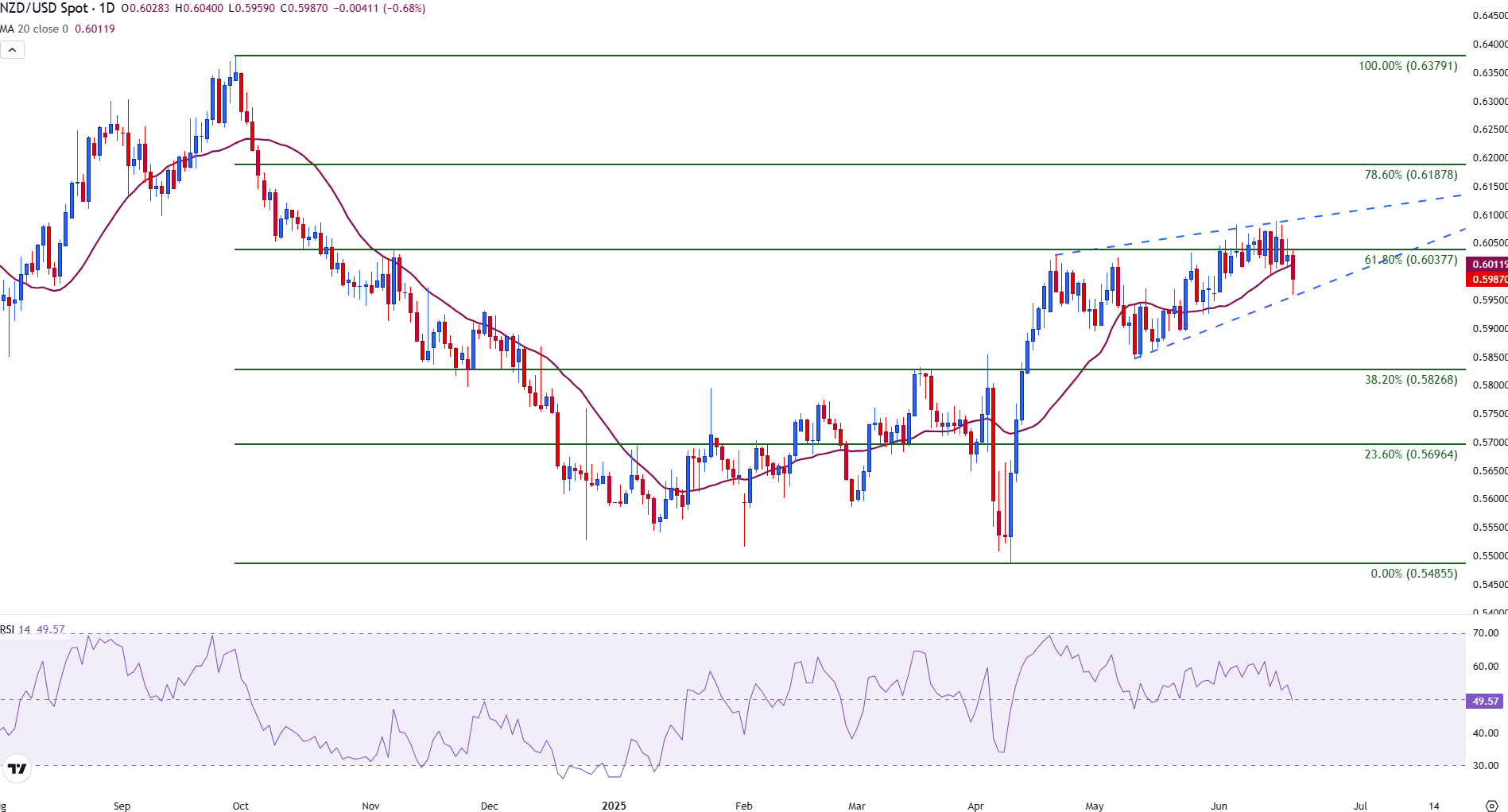- The NZD/USD goes back while the Fed maintains its “data dependent” position.
- The USD is strengthened while the NZD falls, with light volumes limiting volatility in the middle of the holiday in the US.
- New Zealand GDP exceeds expectations; However, the economy remains in contraction territory.
The New Zealand dollar (NZD) is still under pressure on Thursday, with the NZD/USD sliding around 0.5980 while the US dollar extends its profits. The par broke below the simple mobile average (SMA) of 20 days in 0.6012 and the lower edge of an ascending wedge pattern, a movement that suggests that the bullish impulse has vanished. The price action now reflects a growing downward pressure while operators respond to contrasting economic signals from both economies.
The last Federal Reserve Policy (FED) update delivered a more aggressive tone than the markets had anticipated. While the rates remained unchanged, the Central Bank raised its inflation prognosis and pointed out the probability of two rate cuts this year.
This change, together with the caution comments of the president of the FED, Jerome Powell, about inflation and geopolitical risks, has reinforced the fortress of the US dollar and has left the currencies sensitive to risk, such as kiwi, struggling to find support.
Meanwhile, the recent economic data in New Zealand have done little to inspire confidence. Consumer inflation was softer than expected, which led markets to reduce their expectations of greater hardening by the New Zealand Reserve Bank. Some participants are even beginning to deduct the possibility of rates cuts if internal growth continues to weaken. In addition, the latest dairy products revealed another price drop, which was a setback for one of the country’s key export sectors.
Perspectives are even more cloudy by local political challenges. The Government faces criticism for the affordability of housing and salary disputes in the public sector, developments that are weighing on the feeling in the country. With few positive catalysts on the horizon, the New Zealander dollar has been exposed to external pressure and a risk appetite of investors in decline.
The technical analysis of the NZD/USD indicates the potential of a bearish reversal
In the Technical Front, the NZD/USD has broken key support levels, reinforcing the bearish bias. The fall below the 20 -day SMA and the formation of an ascending wedge confirm a reversal of the previous bullish trend. The old support zone around 0.6012 now acts as an initial resistance.
A recovery above this level would lead to 0.6060 to the focus, which aligns with the upper part of the previous wedge and the recent maximum oscillation.
Down, the torque is testing the fibonacci setback of 23.6% of the rebound from April to June, located around 0.5953. A closure below this level could open the door to 0.5850, a region that acted as a support during the April consolidation. Below that, the attention would focus on the deepest backward zone about 0.5736, which aligns with the minimum of early April.
Impulse indicators also point down. The Relative Force Index (RSI) has fallen below the neutral line of 50 and continues to descend, but is not yet in overall territory. A sustained movement below 45 would indicate a growing downward pressure.
NZD/USD DIARY GRAPH

New Zealand Faqs dollar
The New Zealand dollar (NZD), also known as Kiwi, is a well -known currency among investors. Its value is largely determined by the health of the neozyous economy and the policy of the country’s central bank. However, there are some peculiarities that can also make the NZD move. The evolution of the Chinese economy tends to move Kiwi because China is the largest commercial partner in New Zealand. The bad news for the Chinese economy is probably translated into less neozyous exports to the country, which will affect the economy and, therefore, its currency. Another factor that moves the NZD is the prices of dairy products, since the dairy industry is the main export of New Zealand. The high prices of dairy products boost export income, contributing positively to the economy and, therefore, to the NZD.
The New Zealand Reserve Bank (RBNZ) aspires to reach and maintain an inflation rate between 1% and 3% in the medium term, with the aim of keeping it near the midpoint of 2%. To do this, the Bank sets an adequate level of interest rates. When inflation is too high, RBNZ rises interest rates to cool the economy, but the measure will also raise bond performance, increasing the attractiveness of investors to invest in the country and thus boosting the NZD. On the contrary, lower interest rates tend to weaken the NZD. The differential type of types, or how they are or is expected to be the types in New Zealand compared to those set by the Federal Reserve of the US, can also play a key role in the NZD/USD movement.
The publication of macroeconomic data in New Zealand is key to evaluating the status of the economy and can influence the valuation of the New Zealand dollar (NZD). A strong economy, based on high economic growth, low unemployment and high confidence is good for NZD. High economic growth attracts foreign investment and can encourage the New Zealand reserve bank to increase interest rates, if this economic strength is accompanied by high inflation. On the contrary, if the economic data is weak, the NZD is likely to depreciate.
The New Zealand dollar (NZD) tends to strengthen during periods of appetite for risk, or when investors perceive that the general market risks are low and are optimistic about growth. This usually translates into more favorable perspectives for raw materials and the so -called “raw material currencies”, such as Kiwi. On the contrary, the NZD tends to weaken in times of turbulence in markets or economic uncertainty, since investors tend to sell the most risky assets and flee the most stable shelters.
Source: Fx Street
I am Joshua Winder, a senior-level journalist and editor at World Stock Market. I specialize in covering news related to the stock market and economic trends. With more than 8 years of experience in this field, I have become an expert in financial reporting.







